Way back in the Xbox 360 days, indie developer Mommy’s Best Games (maker of the co-op run and gun shooter, Serious Sam Double D XXL) released an Xbox Live Indie Game shoot ‘em up called Shoot 1UP. That game would later gain recognition as an Xbox Windows Phone title, though the phone game lacked multiplayer. Several years later, Shoot 1UP DX is now available on modern consoles and PC, complete with local co-op and lots of surreal sci-fi shooting.
Shoot 1UP DX is a vertically-scrolling bullet hell shoot-em-up (with occasional free-roaming sections). The player’s ship fires a forward blast that can be powered up by collecting items dropped by enemies. Holding the fire button down all the time is an option, but it’s not the only way to fight. Releasing the fire button causes a ring-shaped shield to form around the ship(s). Once the shield forms, pressing the fire button will deliver a strong attack around the ship. The shield does so much damage that it’s practically essential for taking out tougher enemies and bosses quickly, but its short range and charge time add an element of risk as well.
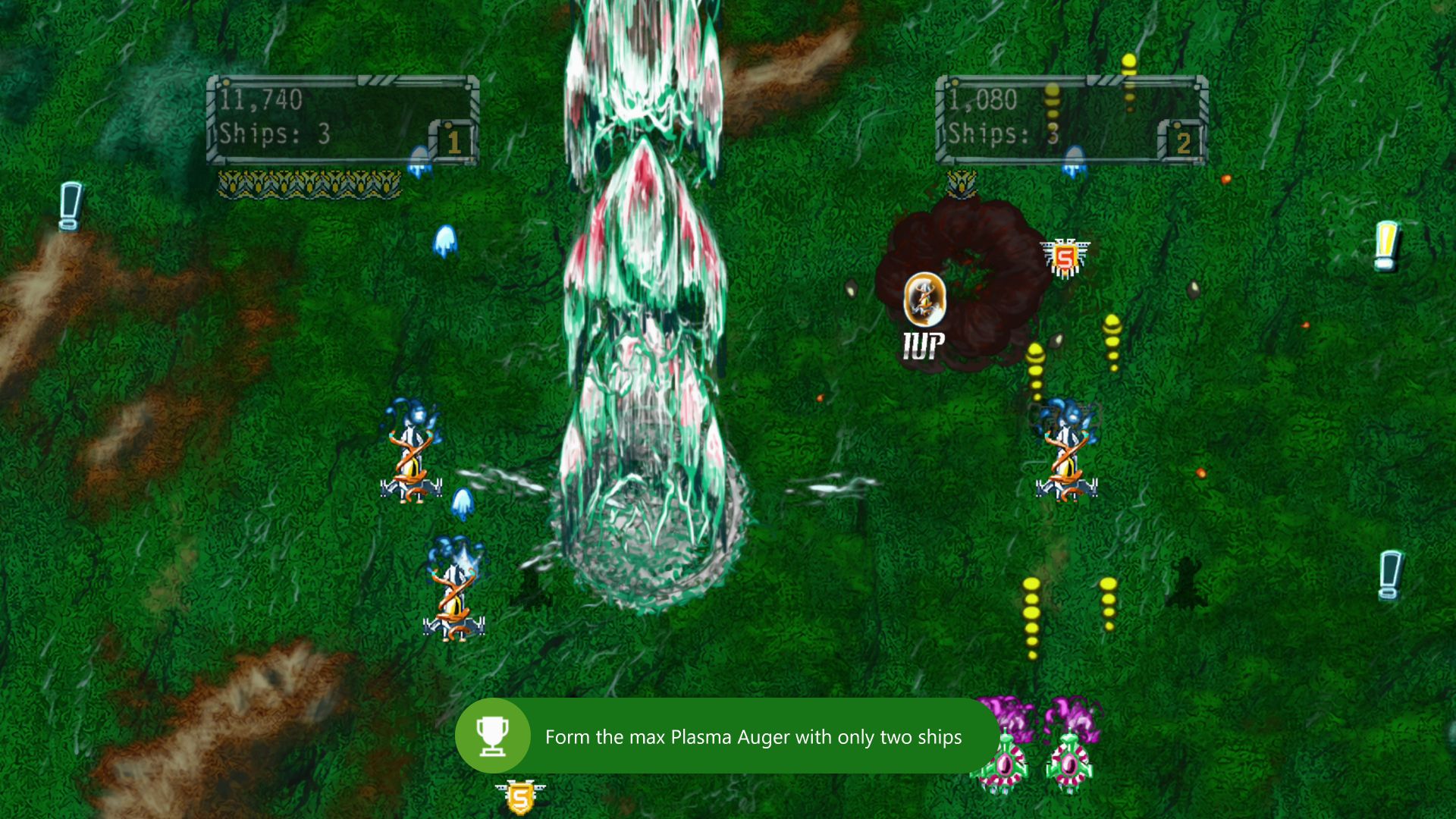
The shield-blast mechanic is innovative enough for a shoot ‘em up, but Shoot 1UP DX has an even more unique mechanic up its sleeve: the titular 1-up system. Collecting the 1-ups that occasionally appear doesn’t give players an extra ship in reserve like it would in most games. Instead, the extra ship immediately joins the existing ship(s) on-screen, increasing the player’s firepower. These ships can all be individually destroyed by enemy fire, and running out of ships leads to a game over (unless you steal a life from your co-op partner). Thankfully, players can contract and expand their formations at will, allowing the management of both vulnerability and spread of firepower.
Shoot 1UP DX’s story mode offers three difficulty selections: Chilled, Normal, and Serious. These descriptions are appropriate, with Chilled and Normal providing a fun but doable challenge to gamers of average skill level. Serious difficulty is certainly harder, but even that can be managed by adjusting the game’s speed. The speed setting can go all the way down to 25% or up to 200%, making even the toughest difficulty as easy or hard as the gamer desires. That’s quite refreshing compared to the nut-kicking difficulty that so many modern shmups go for.
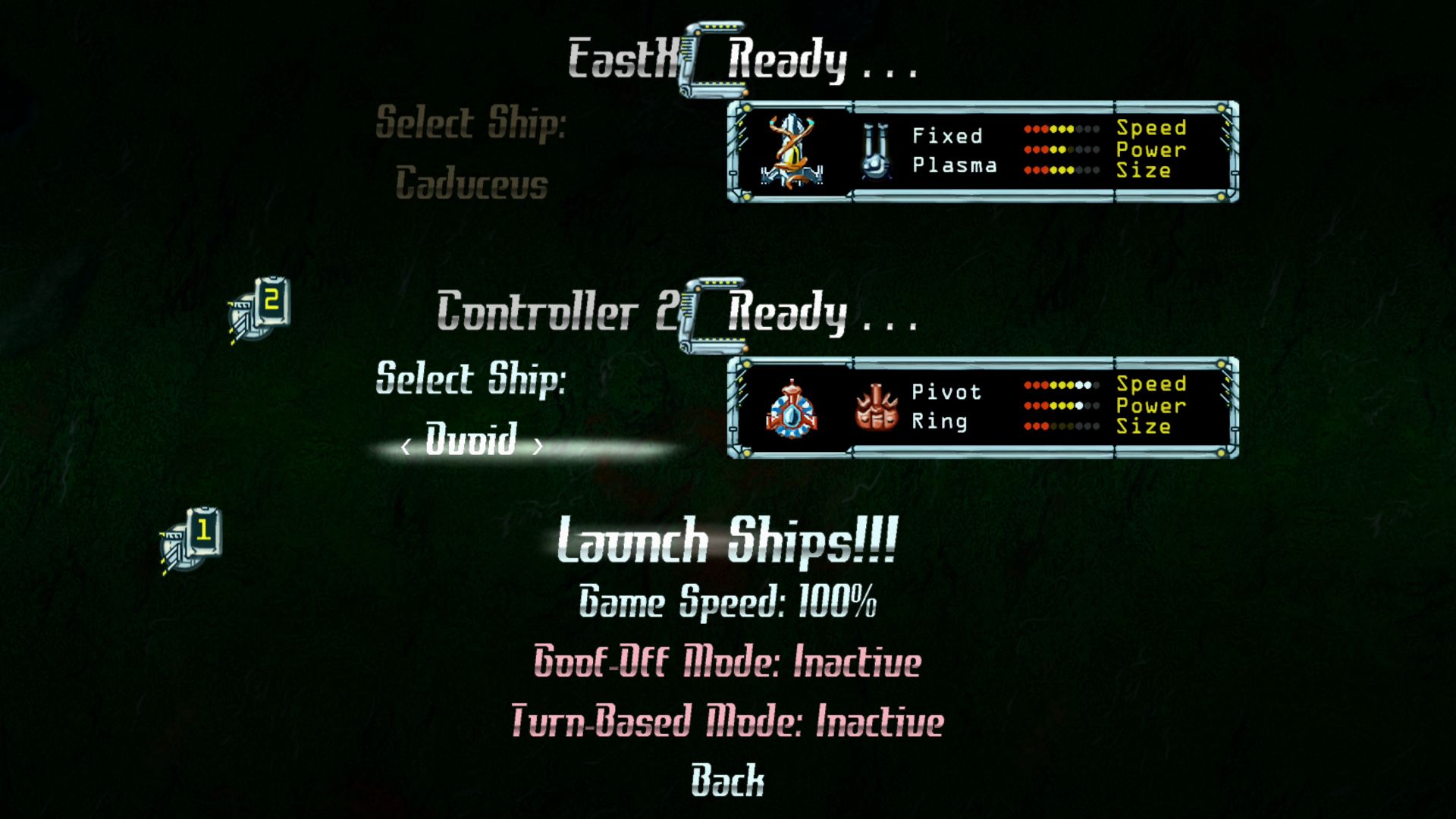
Most of Shoot 1UP DX’s seven stages offer a choice between two paths. The left path is easier and more linear, whereas the right path increases the difficulty by switching from vertical scrolling to free-roaming gameplay. Steering gets awkward in the free-roaming sections, but they contain important items for unlocking additional modes. After playing through the game by taking all right-facing paths, there’s no downside to sticking with the left-facing paths for subsequent playthroughs.
In addition to story mode and its three difficulties, Shoot 1UP DX offers another major mode called Score Trek. This one doesn’t have difficulty settings, but you can still turn the speed down or bring along a co-op partner to make things easier. Score Trek looks endlessly, each subsequent run increasing in challenge. The game saves progress (including power and score) at the beginning of each stage, so players can restart from the beginning of a stage if they fail. Score Trek removes the armada-building mechanic that makes Shoot 1UP so distinctive, but playing with a single ship certainly adds difficulty and variety.
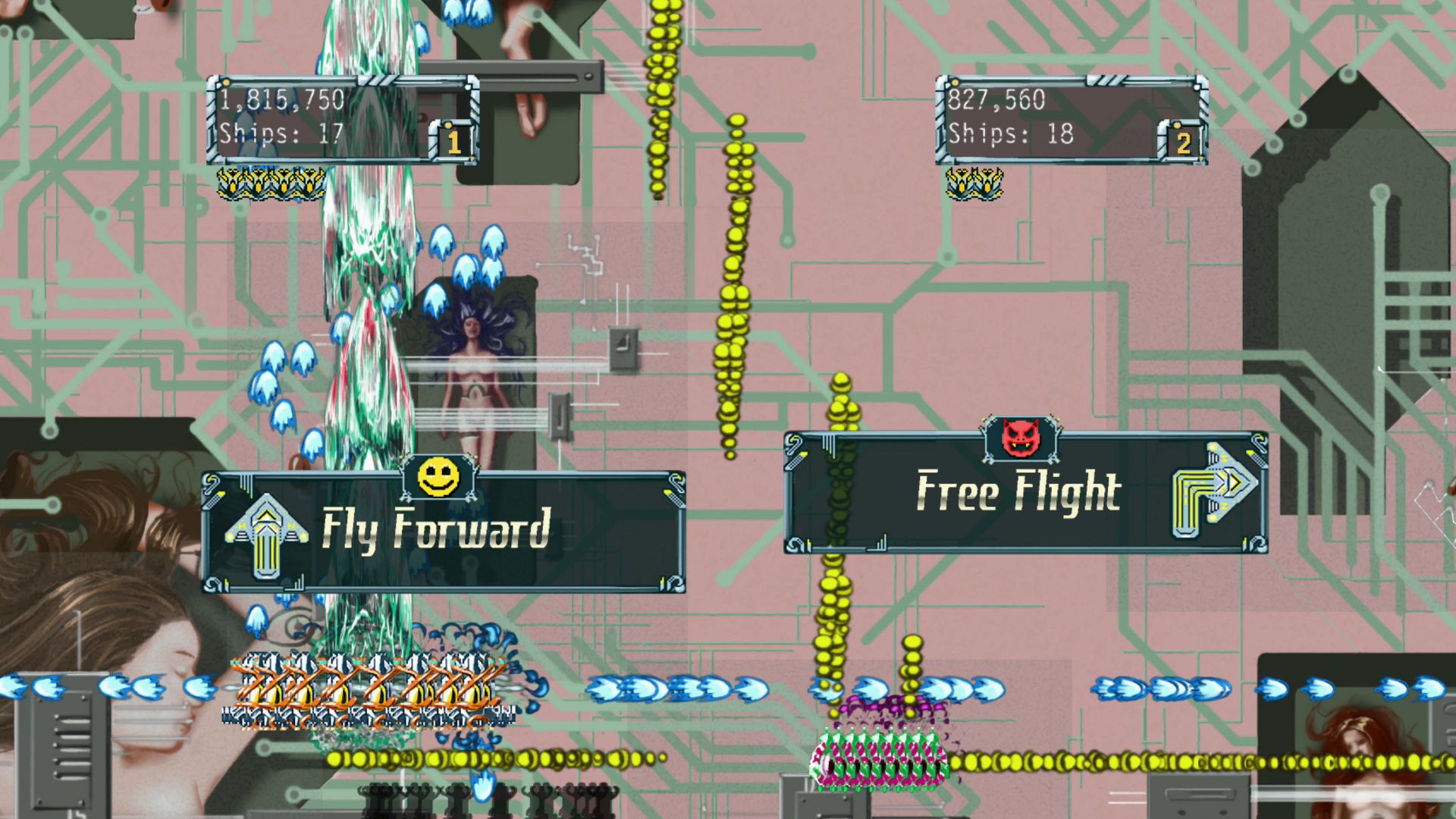
Shoot ‘em ups tend to either have serious art styles (G-Darius HD) or cutesy/silly ones (Q-Yo Blaster). Shoot 1UP DX leans towards the surreal instead. Regular enemies include aliens, ships, and even human aircraft that are overgrown with alien organisms. Bosses tend to be huge and weird, such as a naval battleship overgrown with alien tentacles and a female android whose robo-breasts fire shots from the nipples and eventually detach, launching right at the player. It's all a bit weird, but not especially silly.
Levels also feature cool touches like scattered pieces of famous mechs, mysteriously deceased killer whales, and sleeping android ladies. What the levels don’t have is much (if any) parallax scrolling or any real sense of place. Rather than flying over a terrain that changes as you progress, each level is just made of tiles that don’t change from start to finish. The lack of parallax contributes to the game’s overall flat appearance. It would be cool to see a greater emphasis on level design and visual depth in a sequel someday.
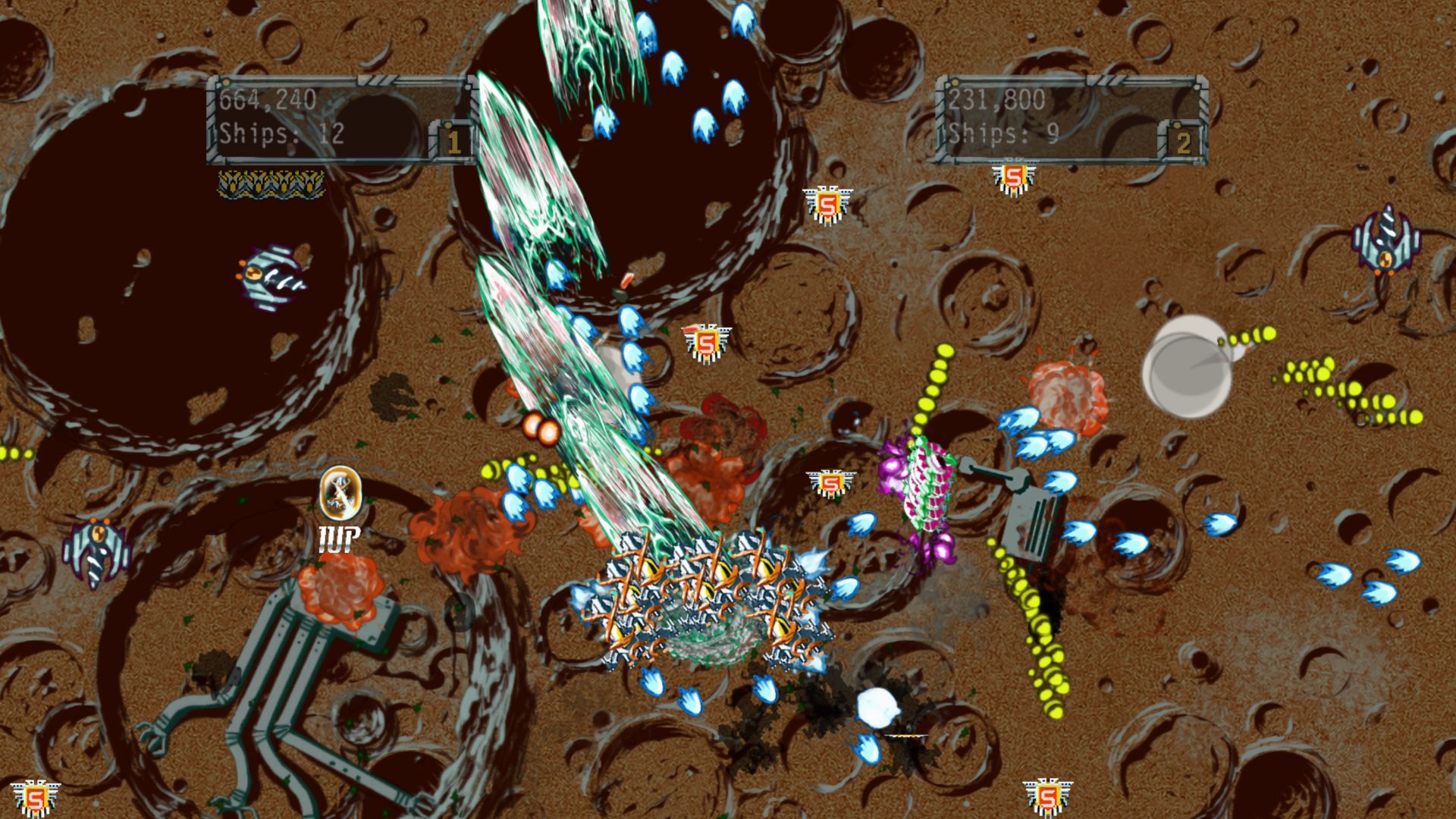
Shoot ‘em ups are almost always better with a friend, and that goes for Shoot 1UP DX as well. A second player can join in at any time in any mode. Both players have their own independent supply of ships, so grabbing an extra ship won’t give a ship to a partner. Each player can build an armada of up to 30 ships, adding up to a whopping 60 ships in total. If either player dies, that player can steal a life by hovering over the surviving player’s ship and pressing a button. A weaker player can even sit out a tough part and then borrow a life when the action dies down. It’s a shame the second player can’t earn Achievements, but there is an Achievement for maxing out both players’ ship counts in co-op.
So many shoot ‘em ups focus on challenge over fun, so it’s refreshing that Shoot 1UP DX takes the opposite approach. This one’s not just about shooting everything that moves; it’s also about building an armada, using shield blasts to take down tough enemies, and choosing different paths to suit the gamer’s skill level. The difficulty is quite reasonable, and all 17 of the Achievements/Trophies should be possible for moderately skilled players. Shoot 1UP DX is also priced very fairly, so shoot ‘em up fans have no excuse not to grab it and shoot one up!
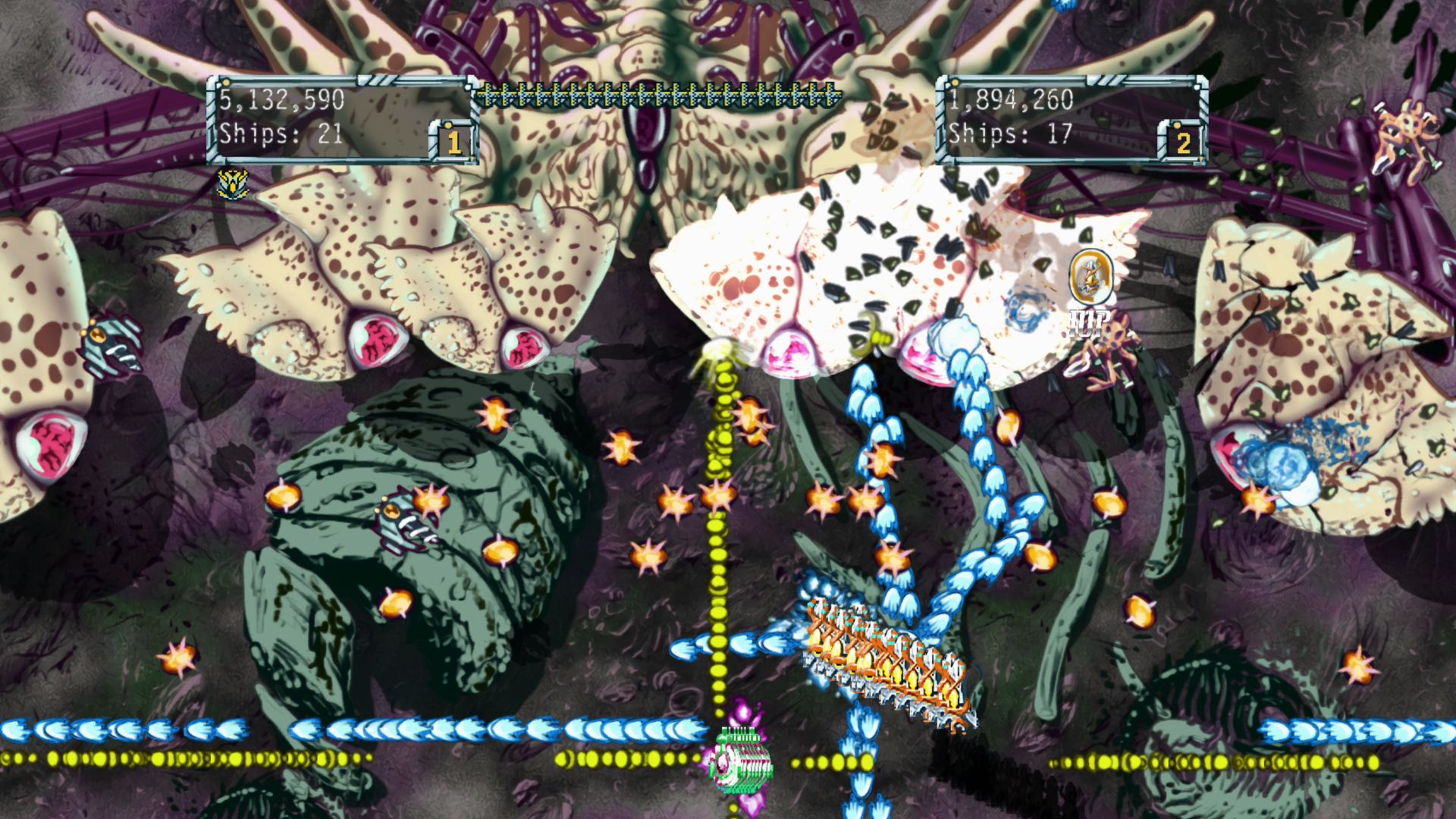
Shoot 1UP DX sells for $5.99 on Xbox, PlayStation, and Switch. The Steam version, simply titled Shoot 1UP, costs $3.99.
An Xbox review copy was provided by the publisher.
Verdict
Co-Op Score
Overall
The Co-Op Experience: Each player can amass up to 30 of their own ships. If a player runs out of ships, he or she can come back by stealing a ship/life from the surviving player.
Co-Optimus game reviews focus on the cooperative experience of a game, our final score graphic represents this experience along with an average score for the game overall. For an explanation of our scores please check our Review Score Explanation Guide.
